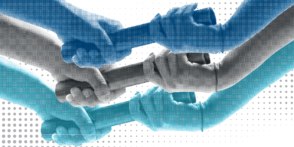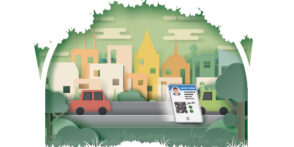The Shrinking Globe
Partnerships with international stakeholders have never been more important. Here’s why.
Building connections between jurisdictions and among leaders is part of AAMVA’s core mission. Yet for much of the organization’s 90-year history, those connections have been based almost exclusively in North America.
Now that’s changing—quickly—as topics such as mobile driver licenses and autonomous vehicles lead governments around the world to grapple with a fast-changing landscape that includes pressing issues related to interoperability, data sharing and emerging technology. AAMVA is not only collaborating more frequently and more substantively with peer organizations such as the Association of European Vehicle and Driver Registration Authorities (EReg) and Sydney-based Austroads, but also working with partners at the United Nations and the International Organization for Standardization (ISO) to ensure that the regulations and standards around these new technologies will accommodate the needs of stakeholders across the globe.
“Part of the reason that the AAMVA community is so collaborative is because lots of issues don’t stay within state borders. With the global world today, those issues don’t stay within country borders, either,” says Christine Nizer, former chair of AAMVA’s International Board of Directors and administrator of the Maryland Department of Transportation’s Motor Vehicle Administration. “There are a lot of common issues that we’re all facing, so we’re trying to figure out how best to come together.”
One of the primary catalysts of those efforts was a 2018 summit in Melbourne, Australia, designed to bring AAMVA, EReg and Austroads together to discuss digital credentials and autonomous vehicles. The idea was that if people from the three organizations gathered in the same room, they’d not only make progress on the agenda items—which included topics such as data sharing and vehicle identification—but also would discover unexpected ways to work together.
That’s exactly what happened.
Prior to the summit, international partnerships were a bit of a back-burner initiative, according to Mike McCaskill, director of identity management at AAMVA. Since the summit, they’ve shifted into a higher gear.
“We’d been gradually getting there, getting there, getting there. After the summit, the amount of interaction and collaboration we’ve had with those other global entities really started to increase,” says McCaskill.
That’s because once leaders from the three organizations finally gathered, they saw how much they had to offer one another.
“Initially, folks were maybe a little skeptical about how much we truly have in common,” Nizer says. “But then as you start having conversations, you realize that the components of what we’re doing are all the same—even if we have different governance and regulatory schema. Ultimately, even those of us who knew that there was a lot of commonality were still surprised by the breadth of it. We’re probably just scratching the surface.”
Preparing for an mDL future
One of the key topics driving the current wave of international collaboration is the expansion of mobile drivers licenses (mDL)—both because jurisdictions around the world are eager to adopt best practices, and because interoperability is essential to mDL’s success. AAMVA is at the center of those efforts: Loffie Jordaan, a business solutions architect at AAMVA, is the convenor of the ISO committee developing an mDL standard, and as part of that process has reached out to affected groups around the world—not just governments, regulators and developers of the standard, but also downstream stakeholders such as relying parties who will use mDL systems to verify presented credentials.
“You get better acceptance and a better product if you consult people worldwide,” says Jordaan. “When you build your solution to accommodate a broader user base, you improve the prospects of adoption and of consequential interoperability.”
To that end, mDL leaders from around the world met in Brisbane, Australia, in December 2022 for a test run to see whether the standards under consideration can support international credential sharing. Then in February, AAMVA, EReg and Austroads will meet in Brussels, Belgium, for a second international summit.
International collaboration “has sparked a lot of enthusiasm. We’re realizing that we’re not alone, that other people are doing this across the world, and we can learn from each other,” says Geoff Allan, CEO of Austroads, covering Australia and New Zealand. “It’s also given us a focus in terms of taking a common approach to mDL, especially now that we’re getting to the point where hopefully this can be proven to work across borders.”
The collaboration between AAMVA and Australia also has extended beyond mDL. For example, Austroads recently revised its driver training handbook based substantially on materials AAMVA developed for use in North America.
Autonomous Vehicles approaching
Bernard Soriano, a member of AAMVA’s Region 4 Board and deputy director of the California Department of Motor Vehicles, was a busy man at the 2018 summit. California, of course, is home to Silicon Valley, where several of the leading autonomous-vehicle (AV) companies such as Google’s Waymo and General Motors’ Cruise are developing and testing their products. Officials around the world are preparing for the emergence of AVs, and interest abounds in the latest news out of Soriano’s home state.
AAMVA’s international partnerships have paved the way for a series of AV information-sharing agreements between California and countries including Singapore, Japan and the Netherlands. Soriano’s team shares information related to AV passenger vehicle tests, often related to the causes and frequency of AV testing crashes. In exchange, Soriano gains insight into the AV learnings gathered by those international partners. In Singapore, for example, officials are examining how AVs can help move shipping containers from urban ports onto roadways—an industrial application that could be appealing in several of California’s urban port cities.
“There are so many unknowns, and so many different business use cases,” says Soriano. “There’s a learning process with this emerging technology, and the information exchange has been valuable for California and for the United States.”
California also signed a letter of intent for an AV information-sharing agreement with the Netherlands Vehicle Authority (RDW), where EReg Chairman Servi Beckers is director of corporate strategy and external affairs. EReg leaders visit the U.S. for at least one AAMVA conference per year, and AAMVA also sends a group to Europe annually.
The AV agreements “are not just about exchanging knowledge, but also about strengthening the relationships,” says Beckers. “What AAMVA did was make the link and provide the opportunity.”
Practical experience with global implications
AAMVA’s expanded international collaborations aren’t limited to partnerships with peer organizations; AAMVA also is helping to shape worldwide road safety guidelines through participation in the United Nations Global Forum for Road Traffic Safety, called WP.1. The WP.1 group works through topics ranging from distracted driving to pedestrian safety, and shares best practices with member nations. The working group’s members are primarily government experts, which leaves plenty of room for outside contributions from industry and academia—as well as from AAMVA, whose members’ state-level vantage provides crucial insight into the most urgent issues affecting North American motorists.
“AAMVA brings practical experience to the table—what works, and what doesn’t. They’ve been making significant contributions and play a key role in our success,” says Jane Doherty, director of international policy, fuel economy and consumer program at the National Highway Traffic Safety Administration within the U.S. Department of Transportation and U.S. delegate to WP.1.
Doherty says that by sharing practical strategies and success stories that have worked across multiple American jurisdictions, AAMVA has repeatedly informed the U.N. Group’s guidelines, as well as benefited from insights from international partners.
AAMVA and its members have long recognized the value in bringing different jurisdictions and industry partners together to share knowledge and develop collaborative solutions. AAMVA’s expanded international partnerships represent an extension of that vision—but one that’s very much in keeping with its mission.
“We’ve been bringing partners together for a long time. We have expertise in that, and in working with them to develop best practices,” says AAMVA’s McCaskill. “Now other parts of the globe are looking to us for that help, too, because we have some really good best practices and standardization processes that work.”
Hear more from Geoff Allan in AAMVAcast Episode 135 tinyurl.com/3v6uef9w.




